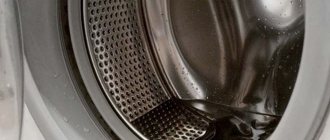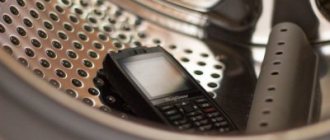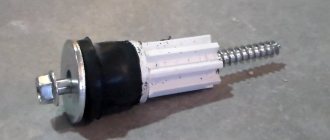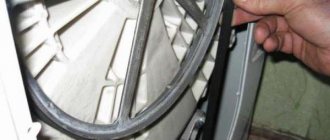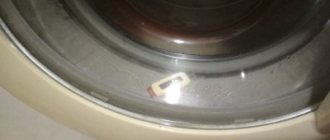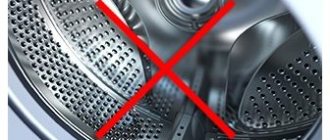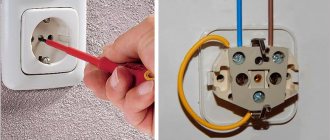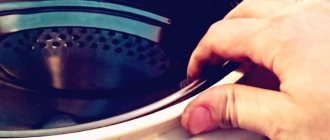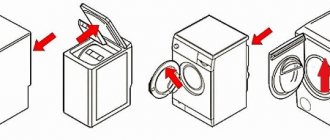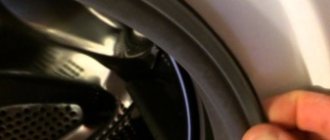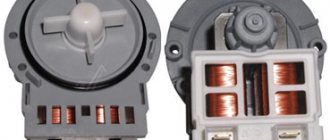Cleaning the filter
The drain pump filter is an important part of the machine; if you do not pay proper attention to it, sooner or later a blockage will form and the washing machine will not drain water at all. There is no need to invent any complicated cleaning methods, everything is extremely simple. To do this, you will need a small container, a towel or rag, or any flat object that will help open the hatch.
The order is:
- Open the hatch to gain access to the filter drain hose.
- Before unscrewing the filter, lay down a rag (towel) and place a container - a small volume of water will flow out of the hole. Maximum - 0.5 l, very rarely more.
- After removing the lid (unscrewing it completely), you need to remove accumulated debris, dirt, sometimes there are coins, wool and other foreign objects.
- Wipe the hole, rinse the lid, reassemble in reverse order.
The washing machine also has a water inlet filter, which should also be cleaned. Over time, clogging with rust and sand occurs. If these deposits are critical, then an error appears on the machine screen, which can be interpreted as “water collection is impossible.”
Important! The hose located directly on the water supply should be cleaned no more than 2-3 times a year.
The process looks like this:
- Close the water supply tap to the device.
- Open access to the back cover; often the device needs to be unfolded.
- The water supply hose is located at the top right.
- You should unscrew the nut that secures it counterclockwise.
- You can see a mesh filter inside. It should be removed and washed with a toothbrush under running water.
- All that remains is to put the filter in place and screw on the hose.
Cleaning the body, door and sealing rubber
The rubber seal or cuff of the washing machine is a mandatory element of cleaning during the maintenance process. Rubber should be cleaned carefully, but efficiently, so that there are no leakage problems. Dirt and mold accumulate in this place - which is why it is important to clean regularly. Sediments in this area contribute to the appearance of unpleasant odors.
Any cleaning agent will help in the process, including regular baking soda. In some cases, if mold and a strong smell have already appeared, then it is worth using household chemicals:
- "Domestos".
- "Comet".
- “Whiteness” - it cannot be used often, as this leads to the destruction of the rubber seal. As a result, it will need to be changed.
The order for different means does not differ; it looks like this:
- Apply the product to the sponge.
- Carefully unscrew the cuff of the washing machine towards you.
- Wipe the metal elements of the housing.
- Clean the rubber itself. And not only in the lower part, where dirt accumulates the most, but throughout the entire diameter.
Important! Do not rub very hard so as not to damage the elastic band and other elements of the machine.
You also need to clean the car door. This can be done using a vinegar solution; you will need a 50% concentration of vinegar essence. It’s not difficult to prepare – just take equal parts of essence and water and mix well. All that remains is to wipe the glass and wipe it dry with a dry cloth. Gloves should be used when working with the solution.
The external elements of the washing machine should be wiped with a damp sponge; if necessary, you can use the existing cleaning agent.
Useful tips
- During the washing process, use exactly the amount of powder, conditioner, and bleach that is needed. Excess will settle in the appliance, which can cause dirt and odors.
- Before washing, remove excess from all pockets.
- If dirty things are in the drum, then there is no need to delay the start. The same goes for removing washed laundry.
- For washing, use low and medium temperature modes more often - this also prevents the appearance of scale.
- If the water is hard, then an excellent method of prevention would be to use a magnetic filter in front of the water supply hose.
- After washing, leave the machine door open.
Cleaning the drum with baking soda
The drum is easy to clean; to do this, you need to prepare a paste of water and soda. Apply it to the drum using a sponge and rub. After cleaning, rinse with water and wipe dry. Soda perfectly helps to cope with mold and fungi, which happily settle in such comfortable conditions. To prevent the formation of mold with this simple remedy, you should clean your washing machine at least once a week.
Advice! In a similar way, you can clean the drum inside the device with Domestos.
Painting
The easiest way is to restore the surface using aerosol paints. You can purchase special white enamel in stores, which is applied over the primer.
The process of painting with paint is similar to priming:
- From the same distance, paint is applied to the surface.
- Half an hour later, after complete drying, a second layer is applied.
- If necessary, you can sand the surface with fine sandpaper and apply a final third layer of enamel.
At a temperature of +25ºС, the enamel dries completely in 30 minutes, but it becomes fully ready to withstand temperature changes and exposure to aggressive environments (for example, powder and detergents) after two days.
After painting is completed and the enamel has completely dried, the tape and film are removed and you can continue to use the washing machine, without the risk of rust appearing on the treated surfaces.
White enamel for household appliances is specially created for the restoration of refrigerators, washing machines, freezers, etc. Another method for restoring a rust-damaged surface, although more complex, requires primary skills in using a grinding machine.
The problem areas of the washing machine must be washed and cleaned, then the rust must be removed using a cleaning wheel and a rust converter must be used. Use a 120-grit sander to sand all areas where there was rust. Then sand the entire part completely with 220-320 grit (so that after painting there is no freshly painted stain left).
After this, you can begin to apply acid primer - lessonal in one layer and after complete drying - the filler itself in two layers. The primed surface should be sanded with 500-600 grit using a machine, and then manually with 1000 grit. All that remains is to prepare the surface for painting - clean, degrease and remove dust. After painting, the surface is varnished.
Rust on the washing machine
Hi all! Tell knowledgeable people what is the best thing to do if the paint on the washing machine chips and rust forms. There is already quite a lot of it. How to prepare the surface and what to paint with? It is desirable that it protects for a long time.
- View profile
- Private message
Actually, sandpaper-degreasing-car enamel. But in this case, IMHO, this is a poultice for the dead. It's almost eaten through there already.
- View profile
- Private message
And if it eats to the end, then what can be done? And I’m also wondering: is there any other protective wall behind the body, or will water flow if there is a hole?
- View profile
- Private message
Konvip wrote: And I’m also wondering: is there any other protective wall behind the body, or will water flow if there is a hole?
Do you think there is water behind the wall? It's just a casing, and nothing more, you can even turn it into a sieve.
- View profile
- Private message
Konvip wrote: if it eats to the end, what can be done?
- View profile
- Private message
Konvip wrote: How to prepare the surface and what to paint with? It is desirable that it protects for a long time.
thoroughly clean everything that is rusty and swollen to pure iron. Degrease, for example, with Galosh gasoline, and putty with polyester car putty a la Teeneysik. After the putty has hardened, carefully and evenly sand it, remove the dust, and smoothly apply a couple of layers onto the undamaged paint. re-enamel in small tubes (12-50 ml) of the desired color.
Konvip wrote: And if it eats to the end, what can be done?
clean, degrease, then
- composition of the “cold welding” type
- or epoxy. (polyester) putty (with fiberglass for strength and reinforcement)
- View profile
- Private message
The main thing is to look inside: where is the water splashing from? It just won’t rust, will it?
- View profile
- Private message
Primer is a must for metal; no repaint will last without it, unless for a short time and for decoration. In my opinion, GF-021 and its variations are not bad, i.e. acrylic primers. If you can’t get it down to metal completely, then at least use a rust converter.
- View profile
- Private message
Yes, it was so rusty because when I moved the machine it hit the bathtub a little.
- View profile
- Private message
Serg SA wrote: Primer is a must for metal, no repaint will last without it, unless for a short time and for decoration.
Serg SA wrote: In my opinion, GF-021 and its variations are not bad, i.e. acrylic primers.
GF - Glyphthalic, has nothing to do with acrylic.
- View profile
- Private message
Degreasing, acrylic primers, auto enamel. 2Konvip Judging by the photo, this hole hasn’t bothered you at all for several years, so cover it with white tape and forget it
- View profile
- Private message
witch wrote: therefore - cover it with white tape and forget it
This is what was proposed:
Hubert wrote: Seal with self-adhesive
- View profile
- Private message
By the way, such a thing was formed from a small scratch in just 3 months
- View profile
- Private message
Konvip, I struggled with the same problem in the summer of 2006, the machine was 3-4 years old at that time. Cleaned it down to metal. A drill with a circular metal brush performed very well: the metal of the SM body was gnawed by rust, not evenly, but in cavities, from which the rust could not be removed by flat grinding. So there was no way to just use sandpaper. There will be dust and noise.
After mechanical removal, I used a rust solvent/converter, or rust dissolver (actually a solution of phosphoric acid), which remained after restoring the enamel on the bathtub. It is very helpful in areas with rust spots located in small cavities, from which neither a brush nor sandpaper can be mechanically cleaned. Then he rinsed it off with plenty of water and dried it with a hairdryer: there was a fear that with natural drying, rust would immediately form on the body again.
Then I applied enamel from a can in several layers. Unfortunately, I didn’t use putty on bare metal. I consoled myself with the fact that I had successfully restored the coating of a bathtub with the same enamel, which means it won’t fail here either.
Very important: I also had rust on the inside of the case, even where there were no through holes on the outside. And in some places, even where everything was clean and beautiful on the outside, but on the inside there was rust. It is clear that by controlling only the external side and not controlling the internal side, we drive the disease inside. So get ready for this. Personally, I dismantled the car almost completely: I removed the engine, drum, counterweights, hatch and scrubbed everything from the inside. I spent a working week with weekends on everything. It was cool ©.
It lasted about a year and a half, and now the machine is “blooming” again. My wife, apparently remembering the last epic, doesn’t nag me, thanks to her. Rust does not yet affect the rigidity of the body - and I gave up on this matter.
By the way, in a fit of self-flagellation, I rushed to an old acquaintance who seriously paints cars, to find out what I did wrong last time (the putty kept tormenting me) and what can be done now. He “reassured” him by saying that he did 3 CM (removed rust and painted) according to the full cycle of technology, i.e. like on a car - exactly the same result: maximum 2 years, and then rust again. In general, he advised not to pay attention to this: the metal of most current SMs is so crappy. I remembered my old (from 1993) activator washing machine “Chaika” (also known as “Siberia”, or something else), all combat-ready and used, but practically free of rust on the body - and agreed.
Why do you need to clean?
The rubber seal has a complex design with bends and folds. Dirt, hair, lint and debris accumulate in large quantities in the folds of the cuff - everything that was not removed through the filter and drain hose.
Due to the configuration, the rubber constantly maintains high humidity , which serves as an excellent environment for mold.
Attention! The remains of garbage are subject to rotting and mold infection, unpleasant odors and black spots appear - colonies of fungi and bacteria.
The musty smell not only creates an unfavorable atmosphere in the room, but also permeates washed clothes. Therefore, a responsible housewife should not have any questions about why the rubber band needs to be cleaned.
Rust on a washing machine can be removed in several ways.
How to remove rust from a washing machine is of interest to many people. When yellow areas and red stains first appear not only on the inside, but also on the outside, it is necessary to immediately eliminate this plaque, which is corroding the metal body. However, in order not to worsen the situation and completely ruin the unit, you need to find out in advance what and how best to get rid of rusty stains.
How to eliminate corrosion on the outside of a washing machine
To get rid of rusty areas, you need to remove the corroded layer using toothpaste and a brush . The product is simply applied to the damaged area, and then carefully cleaned with a sponge and rinsed with water. Then you need to inspect this area and assess the damage: if the result is obvious, then it is best to do the restoration yourself.
Thanks to a special white enamel or zinc primer, you can cover up any pits that may arise . These products can be purchased at a specialized supermarket, telling the seller that the machine needs to be repaired. Then do the following:
- seal the area around the rusty spots with masking tape or polyethylene;
- using fine-grained sandpaper, clean off any remaining rust stains on the body;
- Remove remaining metal and dust with a dry cloth;
- treat the area to be restored with a degreasing compound ;
- shake the can of paint or primer and spray at a distance of 30 cm from the unit;
- if necessary, reapply the layer after half an hour;
- Leave for another half hour until the paint layer is completely dry.
Don’t forget about safety precautions and be sure to wear not only safety glasses, but also gloves. When the paint has dried, remove the film and tape. You can smooth the joint using very fine grit sandpaper.
How to remove rust stains from inside a washing machine
You can get rid of small rusty spots on the inside of the unit using vinegar or citric acid. It is necessary to apply the product to the restoration area and after 1.5-2 hours wipe with steel wool.
Baking soda also helps get rid of corrosion inside the machine. Soda paste should be applied to the rusted areas and after 30 minutes, wipe with a washcloth and rinse with water. Chemicals will help clean the internal parts of the unit if you follow the manufacturer's basic recommendations.
If the body of the machine or drum has serious rust, then they will need to be replaced. In most cases, the components on the back wall of the machine are susceptible to corrosion. For this reason, if you notice yellowness, it must be eliminated immediately.
Ways to help prevent corrosion:
- Rust can be washed off with special anti-corrosion substances , which must be applied for 30 minutes and rinsed off.
- Thanks to a solution of vinegar, hydrogen peroxide and lemon juice in a 1:1 ratio, you can eliminate small yellowed areas . If there is severe contamination, then use a paste with soda. After this, the surface must be wiped with a sponge and washed.
- Place the part with the rusty stain in a container of Coca-Cola . Thanks to the phosphoric acid it contains, rust stains will quickly disappear.
If the above measures are not followed, corrosion will continue to develop, which can lead to complete breakdown of the unit.
What chemicals are best to use?
There are many products that can help eliminate corrosion on the unit. Conventionally, this list of means can be divided into chemical and improvised . The first category is highly effective, but very expensive and you need to buy it at a hardware supermarket. There are several examples of specialized products: YasKhim, Eltrans.
Do not use washing powder to remove rust stains. This can easily damage the body of the unit and lead to the development of microbes in scratches.
Soda, vinegar and citric acid are handy cleaners that every housewife always has. The procedure is the same as with chemicals: apply to corrosive areas and leave for half an hour. Then remove corrosion and clean with a sponge. If the rust is severe, you can use a wire brush and sandpaper.
How to prevent corrosion
If the machine begins to rust, you need to understand the conditions of its maintenance. The situation may repeat itself if it is not urgently changed. Rust appears for several reasons:
- High humidity - Most people install the machine in the bathroom, assuming that this is the best place for it. However, it is not. Due to constant humid air, rust appears.
- Poor and very hard water can also cause corrosion. For this reason, it is best to use a filter and special softeners.
- The washing machine drum must be dry. You can’t leave wet clothes in it, forget to open the door, and don’t wipe it with a dry cloth. Otherwise, rust may appear.
Why is your car affected by corrosion?
Usually, after rust appears on a machine, the owners do not even try to analyze why this happened. Having painted the washing machine, they continue to use it in the same mode, under the same conditions that initially led to the problem. Therefore, the story of metal corrosion often repeats itself.
In fact, everything is obvious. Rust appears on machines installed in rooms with high humidity, or whose body is constantly exposed to water. To prevent the situation from reoccurring, it is necessary to combat dampness in the room.
In general, manufacturers do not recommend using automatic machines in rooms where it is too humid, where steam is generated or condensation appears. Despite this, many owners install washing machines in bathrooms. “Wet” air in such a room is a daily occurrence, so the chance of rust appearing on household appliances is very high.
If the washing machine is installed in the bathroom, then keep the door to the room open at all times. This will help the moisture evaporate. In addition, it is recommended to organize forced ventilation. The lower the humidity level, the lower the likelihood of rust appearing on the automatic machine.
“We put a barrier” to corrosion
It is within the power of each user to prevent the appearance of rust on the SMA. To avoid such an unpleasant phenomenon, it is necessary to maintain a normal level of humidity in the room where the machine is installed, and wipe the case daily with a dry cloth. In addition, it is recommended:
- place a filter element in front of the entrance to the machine - it will trap impurities contained in tap water;
- once every 3-4 months, do a dry wash with citric acid or vinegar;
- periodically wipe the body of the “home assistant” with a vinegar solution with added salt;
- After each use of the washing machine, wipe the powder receptacle and drum cuff dry, leave the door open for ventilation.
It is strictly forbidden to rub rusted areas of the machine body with powder or other aggressive means. This will damage the metal even more; harmful microorganisms will “settle” in the scratches. It is better to act “by science” - clean the stains with sandpaper, treat the areas with a special anti-corrosion primer and paint over them with enamel.
Interesting:
- How to clean rust from a washing machine?
- How to get rid of rust in a washing machine
- How to remove rust from a washing machine drum
- What to do if your sneakers turn yellow after washing
- Which Bosch washing machine is better to buy?
- Woolen item shrunk after washing
Reader comments
- Share your opinion - leave a comment
Removing rust from inside the body
If rust has attacked the drum or other internal surfaces of the washer, then the instructions on what to do look different. Completely different cleaners are also used - vinegar or citric acid. They must be applied to areas affected by corrosion, left for 1-2 hours alone, and then thoroughly rubbed with steel wool. Another option is to dilute a slurry from soda and water, lay it in a layer on the rusty areas, remove it with a sponge after half an hour and rinse with water. Special chemicals will also help, but they must be used strictly according to the dosages given in the instructions.
You can remove rust from inside the machine only at the initial stage: if the drum, crosspiece or other structural elements are heavily rusted, only replacing the parts with new ones will help.
In the fight against corrosion, the main thing is to prevent its spread in a timely manner. To prevent it from progressing, it is necessary to treat all stains with anti-corrosion compounds, cleaners or improvised means such as vinegar, peroxide or citric acid . For severe lesions, soda is used. For small spare parts, another method works - place the item in Coca-Cola for 5-10 minutes, which, due to its phosphorus content, will quickly eliminate unpleasant damage.
Article on the topic: How to connect the inlet hose of a washing machine
How to clean mold from a washing machine
As already mentioned, you can use baking soda and citric acid to clean mold from your washing machine. Will also help:
- Whiteness . You will need to pour 1 liter of product into the compartment and turn it on at the highest temperature of at least 60⁰. When the temperature is at its maximum, stop the cycle for 2 hours. After this time, allow the cycle to complete. The use of this cleaning material should not be too frequent, as it has an aggressive effect on some parts of the machine.
- Soda Ash. The cleaning process is the same as usual, but it is worth remembering that this substance is aggressive, so you need to use personal protective equipment during the process. For prevention, it is recommended to add soda ash at each washing cycle.
How to avoid the appearance of berries?
Here are a few ways to protect your equipment from damage:
- If there is a problem with water acidity in the region, it needs to be cleaned, or, more importantly, to immediately install clean water. At first glance it seems expensive. In fact, if you fix the problems associated with the constant repair of equipment, water purification will pay off very quickly.
- In this case, if the reason for the appearance of water is the high humidity of the wind, the machine should be placed in a place where there are no open containers of water, so that you can ventilate the area where it is being used more often.
- If corrosion is detected on the internal parts of the device, it is important to check the connections and fastenings. Most often, rust in the middle of the body appears through the leakage of water from any connections. After troubleshooting, you need to clean the damaged surface and, if necessary, cover it with tarpaulin (after preliminary preparation).
- To prevent rust stains, use special paints for plastic and metal surfaces. Such products are sold in any department with everyday chemicals.
- After the skin cycle, it is necessary to clean the container for the powder, as well as the humic sealant and wipe all elements dry. This will not only prevent the appearance of yeast, but also the development of flowering fungi.
Article on the topic: How to check the power supply of a Samsung TV
If it is corrosive, scale may build up in the machine. To avoid this, regularly carry out cold water without whitening with added citric acid.
